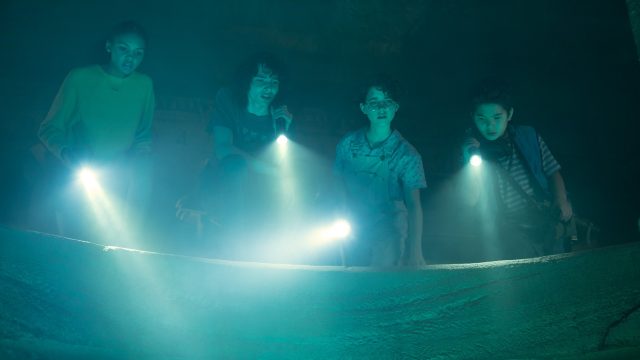This Week You Will Celebrate:
- A new cult film
- An old film in search of a cult
- An aging celebrity with a new look
- A new film with an aging cult
- An new celebrity who looks like an old celebrity
Send articles throughout the next week to ploughmanplods [at] gmail, post articles from the past week below for discussion, and Have a Happy Friday!
At Crooked Marquee, Josh Bell tells of the strange, sordid tale of Hungarian stuntman and Charles Bronson lookalike Robert Bronzi:
Prolific B-movie filmmaker Perez has been instrumental in shaping Bronzi’s bizarre, off-putting screen presence, as the director (and writer and editor and cinematographer) of Bronzi’s first four films. Both From Hell to the Wild West and Once Upon a Time in Deadwood draw on Bronson’s status as a Western icon, with roles in classics like The Magnificent Seven and Once Upon a Time in the West. Bronzi is styled to resemble Bronson in those old Westerns, dressed like a 1970s movie star appearing in a film set in the 1880s. Bronzi’s stunt show experience comes in handy for chases on horseback and shootouts in replica Western towns. He’s great at striking classic-looking hero poses, although that’s pretty much the extent of his acting talents.
Scott Tobais’s New Cult Canon column returns with Solute favorite (or at least curiosity) The Counselor:
This is not how movies are supposed to behave, certainly not when they’re star-packed crime thrillers released by 20th Century Fox. The Counselor (2013) is about a $20 million drug deal gone wrong, and the cartel violence that erupts as a result. And yet the director, Ridley Scott, working from an original screenplay by Cormac McCarthy, stops the action cold for this scene in Amsterdam, which is literally an ocean removed from the border-crossing intrigue in Texas and Ciudad Juárez. It is an inexplicable and intolerable detour for viewers hooked on incident, who must be wondering instead what’s happening with the sewage truck stocked with barrels of cocaine. What’s going to happen at the border? Will the truck reach its intended destination? What forces will come into conflict over its payload? When are they gonna get to the fireworks factory?!
Julian Kimble chronicles the evolution of Will Smith as actor, star and celebrity for The Ringer:
And as blockbuster films began to rely more on the selling power of their intellectual property than that of the names on their posters, an empowered public also opened the concept of celebrity up to greater scrutiny. Even though we collectively maintain an unhealthy appetite for mess (i.e., the reaction to the “entanglement” that Smith’s wife, actress Jada Pinkett Smith, was revealed to be involved in), a global pandemic that has emphasized the demarcating line between the wealthy elite and literally everyone else is among the factors that has forced people to interrogate their relationships with celebrity. As a result, Smith—whose focus on positioning makes perfect sense considering that he’s been so calculated about being famous for so long—has been forced to reassess his own.
At Reverse Shot, Caitlin Quinlan tells the curious story of Nelly Kaplan’s A Very Curious Girl:
Kaplan’s 1969 debut feature is all about objects and the manipulation of their use for personal gain. As an often-objectified woman herself, Marie understands this concept better than any of the residents in her provincial town of Tellier. The villagers harbor a prejudiced hatred for her and her mother, believed to be of Romani origin, and so the two women live on the outskirts of Tellier in a run-down shack in the woods. It is a place devoid of objects until Marie’s mother’s death in a hit-and-run causes a fundamental shift in Marie’s outlook. Where once the townspeople could use Marie for their sexual pleasure whenever they liked, including her lesbian employer at a local farm, now Marie demands payment. Thanks to her clients’ sexual desperation, she uses her newfound wealth to develop and modernize her home. Now she has running water and electricity, but her desires go further than basic utilities; she wants anything and everything, meaningless toys and trinkets, objects with no purpose other than to reflect her ability to own them. Kaplan plays with frivolity here, reclaiming it as an emancipatory, feminine pursuit rather than something to be condemned. As Marie’s house gradually fills with objects, her power intensifies.
The Atlantic‘s David Sims points out that for everything the new Ghostbusters took from the original, it’s still missing a lot:
As goofy as it all sounds, the story is told with a lot of reverential seriousness. The camera lingers with awe on Spengler’s old inventions, which litter the farmhouse he retired to; when his grandkids take the famous ghost-fighting vehicle out for a joyride, a splash of hydrant water reveals the Ghostbusters’ logo. The film seems intent on replicating the mythic aura of Star Wars: The Force Awakens, which was presented to audiences similarly—as a long-awaited return that would deliver on expectations in ways that other Star Wars sequels had failed to do. J. J. Abrams achieved that by harkening back to the spirit of George Lucas’s first movie, wrapping the same heroic story arcs around new characters and surrounding them with aged versions of the older ones. Reitman does the same, but the hushed, majestic approach simply does not fit the material.

